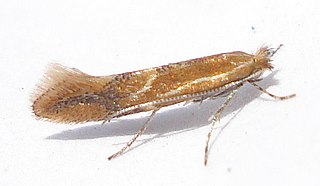
Batrachedra is the largest genus in the moth family Batrachedridae, with representatives all over the world. The early stages of most species are unknown. The genus name is derived from the Greek words batrachos, 'frog', and edra, 'seat', referring to the frog-like resting posture of the adult moths. As of 2018 at least some 114 species are known to belong to the genus.
Paonidia is a monotypic moth genus in the family Erebidae erected by Edward Meyrick in 1902. Its only species, Paonidia anthracias, was first described by Oswald Bertram Lower in 1897. It is found in New South Wales, Australia.
Ascalenia is a genus of moths in the family Cosmopterigidae.
Acridotarsa is a genus of moths belonging to the family Tineidae. The genus was described by Edward Meyrick in 1893.

Phyllonorycter is a genus of moths in the family Gracillariidae.
Crobylophora daricella is a moth in the family Lyonetiidae.

Gracillariinae are a subfamily of moths which was described by Henry Tibbats Stainton in 1854.
Ascalenia epicrypta is a moth in the family Cosmopterigidae. It was described by Edward Meyrick in 1915. It is found in India.
Ascalenia exodroma is a moth in the family Cosmopterigidae. It was described by Edward Meyrick in 1897. It is found in Australia, where it has been recorded from Queensland.
Ascalenia isotacta is a moth in the family Cosmopterigidae. It was described by Edward Meyrick in 1911. It is found on the Seychelles.
Metaprotus magnifica is a moth in the family Crambidae. It was described by Edward Meyrick in 1887. It is found in Australia, where it has been recorded from New South Wales.
Canuza acmias is a moth in the family Crambidae. It was described by Edward Meyrick in 1897. It is found in Australia, where it has been recorded from New South Wales.
Trigonoorda trygoda is a moth in the family Crambidae. It was described by Edward Meyrick in 1897. It is found in Australia, where it has been recorded from Queensland, New South Wales and Western Australia.
"Elachista" cataptila is a moth with an unclear taxonomic position. It was described by Edward Meyrick in 1897. It is found in Australia, where it has been recorded from Western Australia.
Microcolona leucochtha is a moth in the family Elachistidae. It was described by Edward Meyrick in 1897. It is found in Australia, where it has been recorded from New South Wales and South Australia.
Microcolona ponophora is a moth in the family Elachistidae. It was described by Edward Meyrick in 1897. It is found in Australia, where it has been recorded from New South Wales.
Microcolona sollennis is a moth in the family Elachistidae. It was described by Edward Meyrick in 1897. It is found in Australia, where it has been recorded from New South Wales.
Microcolona thymopis is a moth in the family Elachistidae. It was described by Edward Meyrick in 1897. It is found in Australia, where it has been recorded from New South Wales.
Microcolona trigonospila is a moth in the family Elachistidae. It was described by Edward Meyrick in 1897. It is found in Australia, where it has been recorded from New South Wales and Victoria.
Dichomeris holomela is a moth in the family Gelechiidae. It was described by Oswald Bertram Lower in 1897. It is found in Australia, where it has been recorded from New South Wales, Western Australia, the Northern Territory and Queensland.


